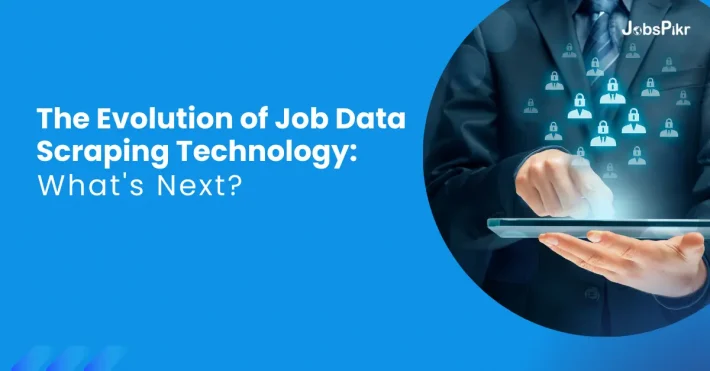In the fast-paced and ever-evolving job market, companies and job seekers alike increasingly depend on the vast troves of data available online to find the best opportunities and talent. Central to navigating this dynamic and competitive arena is job data scraping – an indispensable technique for extracting real-time, relevant job information from a multitude of online platforms, including job boards and recruitment websites.
As the demand for efficient and precise job matching grows, understanding the evolution and the future trajectory of job data scraping technologies is becoming crucial for businesses aiming to maintain a competitive edge and for job seekers striving to stay relevant.
Historical Overview: The Origin of Job Data Scraping
As the internet burgeoned into a universal repository for job listings, early adopters of web technologies recognized a vital opportunity to harness online data for recruitment and job searching. The initial methods of job data scraping relied heavily on manual processes, where individuals or teams would visit job boards or company career pages, copying and pasting relevant information into local databases or spreadsheets. This approach, while straightforward, was not only time-consuming but also limited in scope and scalability. It was impractical to capture the vast and rapidly changing pool of job data spread across the web.
Source: https://webscraper.io/blog/brief-history-of-web-scraping
With the early 2000s came the first wave of automation in job data scraping. Developers began to employ simple bots – rudimentary programs designed to automate repetitive tasks to crawl web pages and extract predefined data fields. These early bots were programmed to recognize specific HTML patterns or tags that denoted job titles, descriptions, salaries, and location information. However, these initial automated systems were brittle; they could break down if a website altered its layout or updated its content management system, requiring frequent manual updates to the scraping scripts.
The limitations of these early scraping technologies highlighted a growing need for more sophisticated tools that could not only navigate complex website structures but also adapt to the continual changes in web technologies. The demand for better tools spurred developments in areas such as artificial intelligence and machine learning, setting the stage for the next generation of job data scraping solutions. These solutions would eventually transform job scraping from a niche technical activity into a critical component of global talent acquisition strategies.
Technological Advancements: The Shift to Automation
The shift to automation in job data scraping marked a significant turning point in the recruitment industry. As technology advanced, so did the tools and techniques for extracting job data, paving the way for more sophisticated, efficient, and scalable solutions. This evolution was driven by several key technological advancements that fundamentally changed how job data could be collected, analyzed, and utilized.
Development of Advanced Web Crawlers
The early 2000s saw a rapid development in web crawling technologies. These advanced web crawlers were equipped to navigate through complex website architectures and could handle various formats and dynamic content powered by JavaScript and AJAX. Unlike their predecessors, these crawlers could interpret and render web pages similarly to a human user, ensuring that more data could be extracted more reliably.
Introduction of Machine Learning
Machine learning algorithms began to be integrated into scraping tools to enhance the accuracy and efficiency of data extraction. These algorithms were trained on large datasets to identify patterns and predict the structure of data within web pages, which allowed them to adapt to new or altered website layouts without manual intervention. This adaptability was crucial for maintaining the continuity of data scraping operations across the ever-evolving digital landscape.
Use of Natural Language Processing (NLP)
Natural Language Processing (NLP) technologies were employed to better understand and extract meaningful information from the textual content of job listings. NLP enabled the automated extraction of detailed attributes from job descriptions, such as required skills, educational qualifications, and job roles. This capability significantly enriched the data collected, making it more valuable for precise job matching and trend analysis.
Implementation of Cloud Computing
The adoption of cloud computing provided the necessary infrastructure to scale job data scraping activities. Cloud platforms offered the scalability to handle vast amounts of data and the computational power to run complex scraping and data processing tasks. This scalability was essential for businesses looking to expand their data-driven recruitment strategies across different geographies and industries.
Enhancements in Data Privacy and Security
As job data scraping technologies advanced, so did the techniques to ensure data privacy and security. New regulations and standards necessitated the development of more sophisticated security measures to protect personal information. Encryption, secure data storage, and anonymization techniques became integral parts of job scraping tools, ensuring compliance with global data protection laws.
The Future of Job Scraping
As we look toward the future of job scraping, the integration of even more advanced AI and machine learning is set to redefine the boundaries of what’s possible. We can expect to see increasingly sophisticated algorithms capable of context-aware scraping, which not only gather data but also understand subtle nuances in job listings, such as cultural fit and indirect qualification requirements.
Additionally, as the Internet of Things (IoT) and big data technologies continue to evolve, real-time job scraping will become more prevalent, providing up-to-the-minute insights into job market trends and enabling proactive responses to labor market shifts. This will be complemented by enhanced ethical frameworks and regulatory compliance measures, ensuring that job scraping technologies advance in a manner that respects privacy and promotes fairness in employment practices. As these technologies mature, job scraping will become an even more potent tool, driving efficiency and inclusivity in the global job market.



